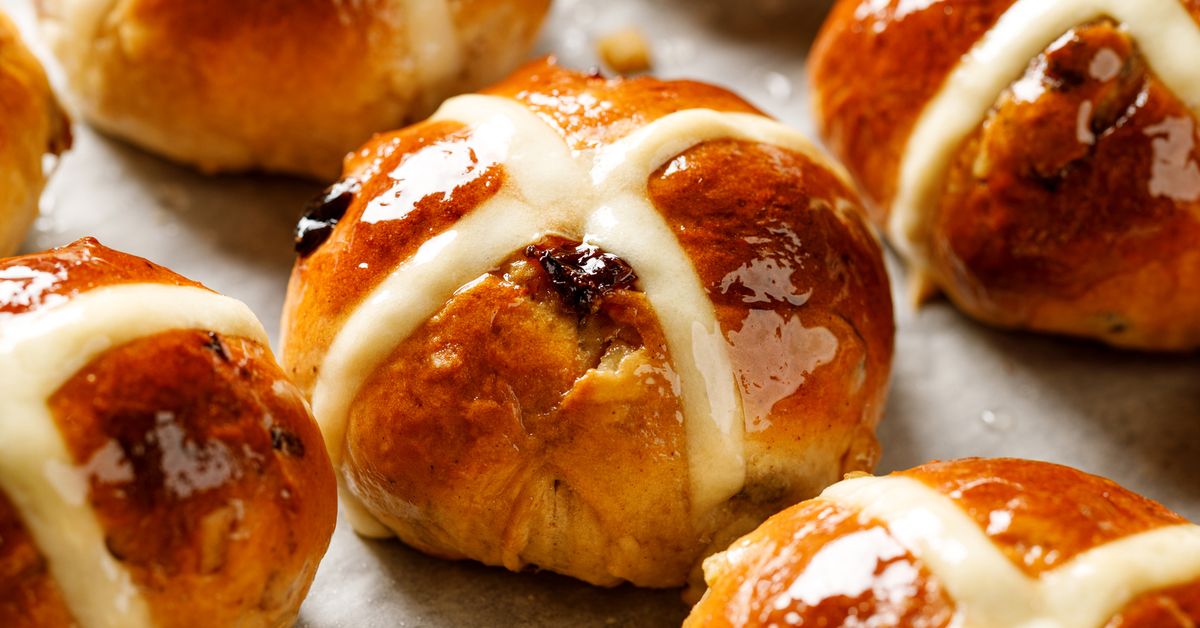The History of Hot Cross Buns

Hot cross buns are more than just a sweet Easter snack; they're a culinary artifact steeped in centuries of history and cultural significance. Their story is a fascinating journey through ancient civilizations, religious transformations, and evolving traditions. From their possible origins in ancient Greece to their modern incarnations in supermarkets, these spiced buns carry layers of meaning in their dough.
In ancient times, bread held a significance that transcended mere sustenance. It was often a symbol of faith and devotion. Ancient Greeks baked round loaves marked with crosses to honor their gods. Some historians suggest that these markings represented the four seasons or the lunar phases. Similarly, Jewish people incorporated special breads into holy observances like Passover. Scholars have long debated whether these customs influenced the emergence of early Christian bread traditions.
Pagan Saxons revered a spring goddess named Eostre, whose name is the root of the word "Easter." They baked bread during springtime festivals to celebrate the renewal of life and the lengthening of days. As time passed, these springtime bread traditions gradually intertwined with Christian practices.
Early Christians began marking bread with a cross as a symbol of their devotion, consuming it throughout the year. They believed that the cross held protective powers against evil spirits and aided in the dough's rising process. As Christianity evolved, the cross on the bread became increasingly associated with Jesus' crucifixion, solidifying its connection to Easter.
By the Middle Ages, the practice of marking bread with a cross became largely confined to Good Friday. A popular legend attributes the creation of spiced buns marked with a cross on Good Friday to a 12th-century English monk, who recognized the day as the "Day of the Cross". Monks frequently used spices to signify special occasions. These spiced buns served as a reminder of Christ's crucifixion and the spices used in his burial.
In 1592, Queen Elizabeth I placed restrictions on the sale of spiced bread and buns, possibly due to religious tensions. England had recently separated from the Catholic Church, and some Church of England officials were concerned that these "holy" buns resembled Catholic superstitions too closely. Some historians argue that the restrictions were related to bread prices and profits, or perhaps the desire to reserve these special treats for specific occasions. The laws dictated that commercial bakers could only produce spiced bread during Christmas, Easter, and for funerals.
By the 18th century, English street vendors were commonly selling "hot cross buns" on Good Friday. A rhyme from Poor Robin's Almanac in 1733 reflects this tradition:
"Good Friday comes this month, the old woman runs, With one a penny, two a penny, hot cross buns."
Superstitions surrounding Good Friday buns soon emerged. People believed that these buns possessed magical properties. Some hung them from kitchen rafters, believing they would never develop mold. They were kept as protection against evil or illness. Those feeling unwell would crumble a piece of an old hot cross bun into water, hoping for a cure. Others placed buns in their grain stores to ward off pests. While these beliefs may seem strange today, they were an integral part of daily life for many.
In Victorian England, people exchanged hot cross buns with friends on Good Friday, reciting the rhyme: "Half for you and half for me, between us two good luck shall be".
Today, the enduring appeal of hot cross buns lies in their flavor. The ancient superstitions associated with the cross have faded, replaced by a focus on taste and enjoyment.
Traditional hot cross buns contain dried fruit and spices like cinnamon and nutmeg. However, modern variations abound, with some substituting sultanas for chocolate chips or incorporating flavors like salted caramel, orange, or even Vegemite and cheese. While they have largely become a secular treat, the cross on top remains a reminder of their Christian origins.
The aroma of a fresh batch of hot cross buns evokes a shared experience that spans centuries. Ancient Egyptians, Greeks, Poles, Romans, Saxons, medieval monks, and 18th-century street sellers all had their own versions of spiced, crossed bread. Each group imbued the buns with its own significance, from honoring gods to celebrating Christ's crucifixion and resurrection.
The consumption of hot cross buns at Easter exemplifies how traditions evolve over time. Once primarily available on Good Friday, they now appear in shops as early as the New Year. These buns have transitioned from pagan festivals to Christian rites, survived royal bans, and navigated waves of superstition. Yet, they remain a beloved symbol of Easter in Australia and around the world, a testament to their enduring appeal and adaptability.











